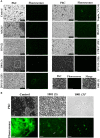Fluorescence Imaging of Streptococcus pneumoniae with the Helix pomatia agglutinin (HPA) As a Potential, Rapid Diagnostic Tool
- PMID: 28769901
- PMCID: PMC5513899
- DOI: 10.3389/fmicb.2017.01333
Fluorescence Imaging of Streptococcus pneumoniae with the Helix pomatia agglutinin (HPA) As a Potential, Rapid Diagnostic Tool
Abstract
Streptococcus pneumoniae is a common human pathogen and a major causal agent of life-threatening infections that can either be respiratory or non-respiratory. It is well known that the Helix pomatia (edible snail) agglutinin (HPA) lectin shows specificity for terminal αGalNAc residues present, among other locations, in the Forssman pentasaccharide (αGalNAc1→3βGalNAc1→3αGal1→4βGal1→4βGlc). Based on experiments involving choline-independent mutants and different growth conditions, we propose here that HPA recognizes the αGalNAc terminal residues of the cell wall teichoic and lipoteichoic acids of S. pneumoniae. In addition, experimental evidence showing that pneumococci can be specifically labeled with HPA when growing as planktonic cultures as well as in mixed biofilms of S. pneumoniae and Haemophilus influenzae has been obtained. It should be underlined that pneumococci were HPA-labeled despite of the presence of a capsule. Although some non-pneumococcal species also bind the agglutinin, HPA-binding combined with fluorescence microscopy constitutes a suitable tool for identifying S. pneumoniae and, if used in conjunction with Gram staining and/or other suitable technique like antigen detection, it may potentially facilitate a fast and accurate diagnosis of pneumococcal infections.
Keywords: Forssman antigen; Streptococcus pneumoniae; binding lectins; fluorescence microscopy; teichoic acids.
Figures







Similar articles
-
Phosphorylcholine esterase is critical for Dolichos biflorus and Helix pomatia agglutinin binding to pneumococcal teichoic acid.J Basic Microbiol. 2020 Oct;60(10):905-915. doi: 10.1002/jobm.202000177. Epub 2020 Aug 27. J Basic Microbiol. 2020. PMID: 32852853 Free PMC article.
-
Structural basis for recognition of breast and colon cancer epitopes Tn antigen and Forssman disaccharide by Helix pomatia lectin.Glycobiology. 2007 Oct;17(10):1077-83. doi: 10.1093/glycob/cwm077. Epub 2007 Jul 25. Glycobiology. 2007. PMID: 17652409
-
Biofilm formation by Streptococcus pneumoniae: role of choline, extracellular DNA, and capsular polysaccharide in microbial accretion.J Bacteriol. 2006 Nov;188(22):7785-95. doi: 10.1128/JB.00673-06. Epub 2006 Aug 25. J Bacteriol. 2006. PMID: 16936041 Free PMC article.
-
The involvement of Helix pomatia lectin (HPA) binding N-acetylgalactosamine glycans in cancer progression.Histol Histopathol. 2000 Jan;15(1):143-58. doi: 10.14670/HH-15.143. Histol Histopathol. 2000. PMID: 10668205 Review.
-
The use of the lectin Helix pomatia agglutinin (HPA) as a prognostic indicator and as a tool in cancer research.Histol Histopathol. 1999 Jan;14(1):217-26. doi: 10.14670/HH-14.217. Histol Histopathol. 1999. PMID: 9987666 Review.
Cited by
-
Phosphorylcholine esterase is critical for Dolichos biflorus and Helix pomatia agglutinin binding to pneumococcal teichoic acid.J Basic Microbiol. 2020 Oct;60(10):905-915. doi: 10.1002/jobm.202000177. Epub 2020 Aug 27. J Basic Microbiol. 2020. PMID: 32852853 Free PMC article.
References
LinkOut - more resources
Full Text Sources
Other Literature Sources
Molecular Biology Databases
Research Materials

